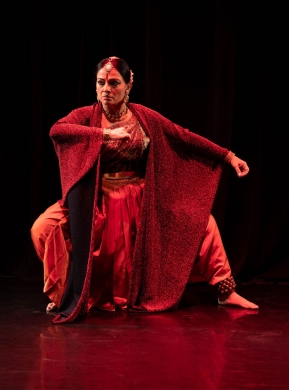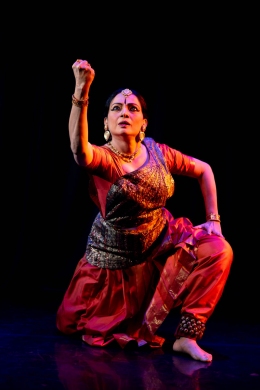
|   |

|   |
The Battle Within - the eternal dilemma - G Ulaganathan e-mail: ulag_nath@yahoo.com Photos: Sudeep Bhattacharya November 17, 2019 'There is a Kurukshetra taking place within each one of us. What began in the battlefields of Mahabharata many, many years ago is still continuing and it is a never ending process.' This was the message that came loud and clear as one watched the mesmerising 70-minute presentation 'The Battle Within' at the fully packed Chowdaiah Hall in Bengaluru on November 2, 2019. 

Malavika Sarukkai had been living with this dream, as she herself puts it, "since my childhood listening to my mother reading out a passage or two from the Gita to me sitting in the corner of our house." It has taken years of research and finally she has been able to transport us to the glorious days of Mahabharata, portraying the two key persona in the drama, Krishna and Arjuna. In the dance presentation 'The Battle Within,' she brings before our eyes the dilemma in the mind of the great warrior and the soothing words of his charioteer, Krishna. And it is not merely a visual treat with excellent video clippings on the background (courtesy Sumantra Ghosal) but the work of a consummate artiste who weaves many designs and takes us on a roller-coaster ride of various emotions. As the curtain goes up, Malavika steps on the stage giving us a glimpse of various avatars of Krishna. She has used the 12th century poet Jayadeva's Gita Govinda to give the audience a peep into each avatar's mission. But to audience which is used to these ten avatars, inclusion of Buddha as an avatar was a surprising element. Then, going straightaway into the text of Bhagavad Gita, Malavika alternates between the roles of Arjuna and Krishna displaying various rasas. As both Krishna and Arjuna blow their conches signalling the beginning of the war, Arjuna develops cold feet. "Oh Krishna, before me, I see my kinsmen thirsting for battle. Watching them, my limbs have turned numb, and my throat feels parched, a shiver runs through my body and my hair stands on end..." The Gandiva slips out of his hand and he slumps on his feet. Malavika's face becomes a kaleidoscope of various emotions - pain, anger, agony and fear - and she brought before our eyes the picture of an ordinary mortal, not a brave warrior who is downcast and confused. The next minute, she was Krishna, the supremely confident charioteer who now comes to his help. "Yield not to unmanliness, Arjuna," he says. "Cast off this faint-heartedness, rise up." And he goes on to explain, "Those who are born must surely die, and those who die will be reborn." There lies the essence of Hinduism -- birth and rebirth. And then comes the assurance, "Arjuna, through the ages, whenever the righteousness decays, I will take form and come amongst you. I manifest myself from age to age (Sambhavami yuge yuge)." As the lord takes the vishwaroopam and convinces the startled Arjuna, he gives answers to many of the nagging doubts in his mind and gives him as well as the entire humanity the confidence that not everything is lost and there is always a ray of hope. Malavika used the entire stage and converted it into the field in the Kurukshetra war. Her body language, fluent movements and various bhavas that switched to various moods and finally the submission to the supreme being when the whole universe slowly moves on (in the background screen) took the appreciative audience to an ethereal world and when the darkness enveloped the auditorium, there was an absolute, stunned silence before the audience erupted into continuous applause. Organised by Kalavahini Trust, the show belonged to Malavika Sarukkai and the audience. No chief guest, no speeches and no felicitations. She had an effective collaborator in Sumantra Ghoshal who also translated the verses. Niranjan Ghokale's lighting and technical designs was also an important element in the successful presentation. Malavika would be taking it across other major cities in India soon. In Bangalore, unfortunately one couldn't see many performing artistes amongst the audience. One doesn't expect senior dancers (as they are either 'busy' or avoid coming if they do not have any role to play) but at least the young students should have come in large numbers. They should realise that like the vishwaroopam, such productions are rare and they may not get to see them again. Anyway, it is their loss. The writer is a senior dance critic based in Bangalore. |